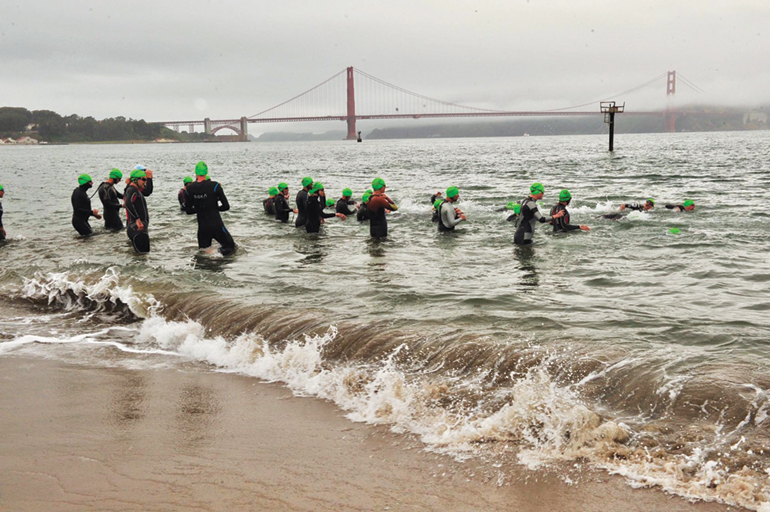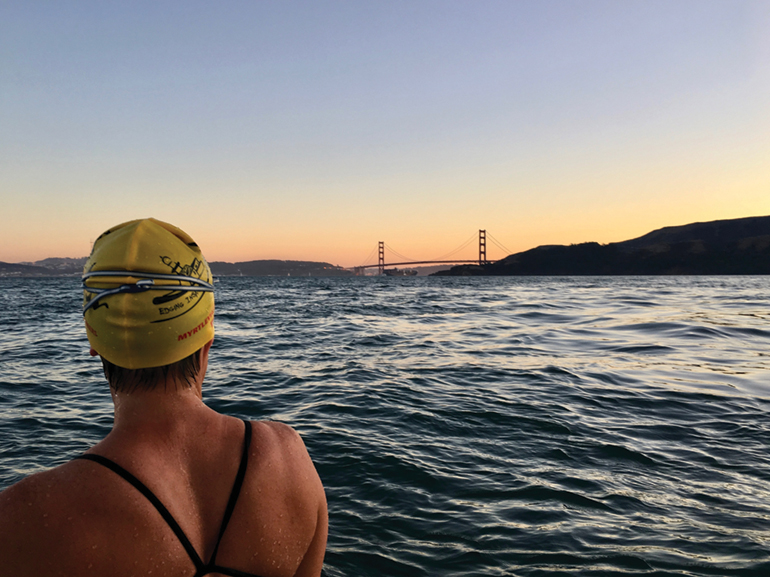“IMAGINE SWIMMING AT Point Bonita (outside the Golden Gate) on an overcast morning with building winds and large rolling 8-foot swells in 50-degree-Fahrenheit water (no wetsuit), then swimming in circles by Point Diablo waiting for a behemoth outbound tanker to pass before crossing under the Golden Gate Bridge where there’s normal chop and churn swimmers affectionately call ‘the washing machine,’ until finally fighting the wind and waves heading north up to Raccoon Strait,” says Sylvia Lacock, co-founder of Pacific Open Water Swim Co. “If anyone saw me out here doing this, they would call me crazy. But I find it thrilling and deeply therapeutic.”
Choosing to swim in cold water sounds like a pursuit from Victorian times, but evidence is emerging that this activity can increase circulation, boost immunity, treat depression and even possibly offset the need for strong painkillers. The theory is that cold water immersion revs up the body’s natural healing powers and that adapting to that situation can eventually reduce susceptibility to stress. And whether open water swimmers engage in the sport for their health, for a boost in adrenaline or because the open water is their element, more and more people are jumping in.

Who takes part?
Those taking the icy plunge are a mix of sizes, shapes, gender and ages, from 80-year-olds who swim daily to 10-years-olds who aren’t fond of traditional swim teams. What they all share is an affinity for endurance sports and taking their body to the edge. “It certainly requires a sense of adventure and throwing away some fears regarding the open water,” Lacock says. “And for marathon swimmers swimming 10 to 20 miles, there needs to be a quite a bit of mental toughness, patience and acceptance.”
Why San Francisco Bay?
“It’s a bit like Goldilocks — just right,” says Kathy Winkler, who works with the open-water group Water World Swim. “The water temperature rarely goes above 65 degrees even in the warmest of months, so swimmers can train year-round in the bay. Even in the winter, the water temperature rarely goes or stays below 50 degrees, making this the ideal place to remain cold-water acclimated,” she says. “Swimmers from around the world come here to train and complete their six-hour sub-60-degree qualifying swim as required before attempting endeavors such as the English or Catalina channels,” adds Sylvia Lacock.

What is the routine?
“Some only swim in the summer, some swim more in the winter, some do it when they are training for an event, some do it every day,” says Suzie Dods, owner of Suzie Dods Swim Coaching. Lacock adds, “It depends on the distance or event they might be training for. And then there are those who need the bay nearly every day for sanity, and a way to start or end the day. We know many people who swim in the bay five to six times per week, year-round.” Dods, who holds the prestigious Open Water Triple Crown for completing a swim of the English and Catalina channels and the Manhattan Island Marathon Swim, says she herself doesn’t get in the water nearly enough these days.
Where do people swim?
Alcatraz is the favorite, inspiring several races year-round, like the Alcatraz Sharkfest Swim in June (using the route prison inmates Anglin Brothers and Frank Lee Morris reportedly picked for their 1962 attempted escape) and, also in June, the Escape from Alcatraz Triathlon, which begins with a 1.5-mile swim off the island. “The more challenging Alcatraz routes,” Lacock says, “are those done in custom or private swims such as Alcatraz to the Golden Gate Bridge or round-trip Alcatraz.” And “the most technically challenging course on the bay is a round-trip Angel Island, starting and ending in S.F.’s Aquatic Park, swimming past Alcatraz, around Angel Island and back to Aquatic Park. To date,” she adds, “only 10 swimmers have completed this marathon swim of 10 miles.”
What are the dangers?
Besides a life-threatening hypothermia risk, there are potential hazards from marine life contact, water pollutants, angry seas, wicked tides, heavy fog, massive tankers and other seafaring vessels, plus physical agony and exhaustion. “I think especially for beginners it’s important to go with a group,” Winkler advises. “It’s a bit irresponsible to go out alone because you never know when a cramp, health issue, crazy seal, or king tide can get the best of you and it’s smart to have someone there to get or give help.”

What keeps people hooked?
Many swimmers say expecting the unexpected is what makes open water swimming exciting. “There is a large element of freedom — freedom from lane lines and pool opening times, and the boredom of mass participation events,” Dods says. “It’s just you and the water — no gear except goggles and a cap. It challenges you to relax because you can’t fight the water; you have to accept it.” Swimmers also appreciate that it’s an outdoor low-impact workout that’s relatively easy on joints. And then there are moms like Lacock, who found it can boost endorphins and combat postpartum depression. “When you are out there, the everyday drama falls away and you can only control your breathing, your stroke and simply moving forward,” she says.
Local Resources:
Dolphin Club
Odyssey Open Water Swimming
Pacific Open Water Swim Co.
South End Rowing Club
Suzie Dods Swim Coaching
Water World Swim
This article originally appeared in Marin Magazine’s May 2018 print edition under the headline: “Dive In“.

